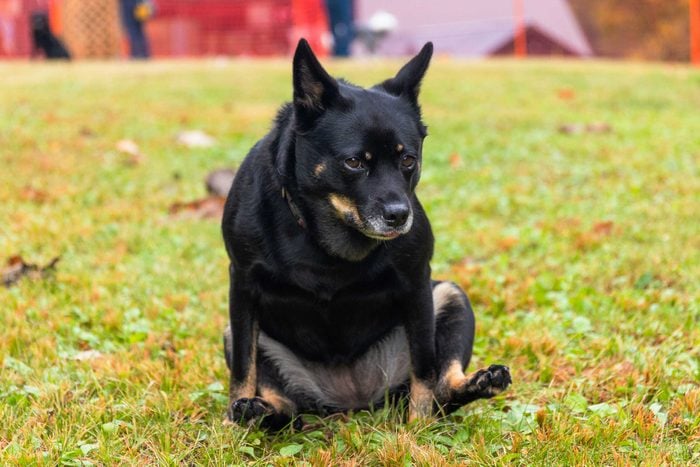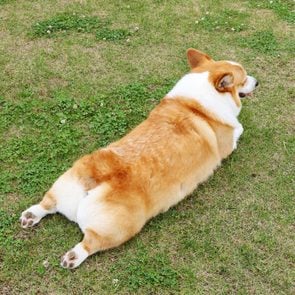Why Do Dogs Drag Their Butts? Experts Explain This Impolite Canine Behavior
Updated: Mar. 05, 2024

It might look comical, but when your dog drags his butt across the carpet, he's trying to tell you something
It’s a staple of every funny dog video montage: Some hapless pup, with his back legs sticking straight up in the air, pulls himself across the floor with his front legs, dragging his behind across an antique Persian rug. In fact, the behavior is so common among our canine friends that it has its own name: dog scooting. “It’s humorous, but it’s also kind of gross,” says Jennifer Hawkins, DVM, executive director of the Southern California Veterinary Medical Association. So why do dogs drag their butts across the floor?
It’s actually not to make themselves famous on YouTube. And it’s not just one of those weird quirks of dog behavior—like the way dogs sniff butts, eat poop, hump pillows, follow owners everywhere, stare, obsessively play with squeaky toys and put their nose in your crotch. “It’s usually a sign there’s something going on with your dog,” says Dr. Hawkins. That’s right: This seemingly silly behavior is usually telling you something important about the health of your pet.
We asked vets your dog-scooting questions: Why do dogs drag their butts? And most important, how can you stop it?
Get Reader’s Digest’s Read Up newsletter for more pets, humor, cleaning, travel, tech and fun facts all week long.
About the experts
|
Why do dogs drag their butts?
In short, dogs scoot because they’re uncomfortable. “They do it because their butt is itchy or sore, and it offers them a little bit of temporary relief to rub that area,” says Dr. Hawkins. “They’re telling you something is not quite right.”
But the trick is figuring why your dog is uncomfortable that way, and it usually comes down to a handful of issues.
There’s a problem with their anal sacs
Anal sac issues are by far the most common reason why dogs drag their butts. The anal sacs are two small glands on either side of a dog’s rectum that contain a foul-smelling fluid dogs use to mark territory and ward off predators when they feel threatened. Normally, the glands empty naturally when the dog defecates, but sometimes the fluid can thicken, and the glands become inflamed.
“The full, impacted anal glands act like hemorrhoids that are itchy and painful,” says Amy Tate, DVM, co-owner of Riverview Animal Clinic in Birmingham, Alabama. “It causes the dog to drag its bottom in an attempt to alleviate the pressure.”
Left untreated, anal sacs can get so full or infected that they can rupture, which can cause your dog a lot of pain. So it’s important to visit your vet if you see your dog routinely dragging its butt on the floor.
What to do: If your dog’s anal sacs aren’t emptying on their own, your vet will need to express the sacs manually. Some animals need their anal sacs expressed routinely. “I usually tell people, If you notice your dog scooting every six weeks, go in every five weeks and ask a staff member to express the anal glands for you,” says Dr. Hawkins. “Or if you’re feeling really brave, you can ask the staff to teach you to do it yourself.”
They have allergies
Sometimes dogs drag their butts simply because they itch. Like humans, dogs can have allergic reactions to environmental factors, like grasses, pollen and foods. And in dogs, the reactions tend to manifest on the skin.
“Where we get sneezing or runny eyes, dogs get inflamed-feeling skin,” says Dr. Hawkins. “It’s why they sometimes chew at their toes and lick their bellies. And it can be a reason they drag their backsides too.”
What to do: “Wipe their skin down when they come back in from being outside to try to reduce the contact with allergens,” says Dr. Tate. “And discuss allergy-management options with your veterinary care team.” Your vet might want to prescribe antihistamines or other medication for your pet and may recommend a special dog food for allergies.
They’ve got a parasite
A tapeworm or other intestinal parasite might also cause your dog to drag its butt across the floor. “If they’re being passed in the feces or wriggling out of the rectum, it can be itchy,” says Dr. Hawkins. “The worm fragments can be small, and you don’t really notice them back there, but they can be a reason for some itching or discomfort.”
What to do: Bring a stool sample for your veterinarian so they can check for parasites.
Something else is bothering their backside
Why do dogs drag their butts if they’re not dealing with a medical issue? It may be a matter of irritation in the area.
For dogs that get groomed, “a recent shave can leave a little clipper irritation,” says Dr. Hawkins. “Or if they have loose stools or diarrhea, it can cause some irritation to the rectum. That can be another reason to drag or rub their bottom on the carpet.”
What to do: Most minor irritations will clear up on their own. Just keep an eye on the area and look out for other signs your dog might be sick or in pain.
When should I worry about dog scooting?
A dog dragging its butt across the floor isn’t always cause for concern, but you don’t want to overlook a potential health issue. So when should you bring your bum-scooting pet to the vet? “I encourage patients to be checked when the scooting behavior is consistent or there is pain associated with the activity,” says Dr. Tate. “So if your pet does not stop scooting or is repeatedly scooting, then it should be checked out.”
What can I do at home to stop dog scooting?
If your dog is routinely dragging its butt across the floor, it’s important to see a veterinarian to make sure you address any serious health issues, like allergies or anal sac problems. But there are also some things you can do at home.
Keep flea treatments up to date
“Ensuring that the pet is up-to-date on their flea and tick prevention protects against flea allergy dermatitis,” says Dr. Tate.
It can also help protect the dog against tapeworms. “Fleas are how dogs get tapeworms,” says Dr. Hawkins, “by digesting a flea that’s carrying part of the tapeworm lifecycle.”
Feed your dog a high-fiber diet
Some dogs that are prone to anal sac issues can benefit from a high-fiber diet. “Dog foods with a little more bulk can help make the stools a little more firm so they do their job and press on the anal sacs as it passes through,” says Dr. Hawkins.
Dog foods that contain probiotics might also be helpful. “If scooting is a recurring problem, something to discuss with your veterinary care team is the use of probiotics to manage any imbalance of gut bacterial flora,” says Dr. Tate. In fact, you’ll want to discuss the best diet for your dog with your vet.
Keep an eye on its behind
Dog parents should also make sure there is no physical obstacle preventing the anal glands from working normally. “If there is hair stuck to the rectum or feces stuck in the hair, then the rectal opening can become obstructed, preventing normal defecation behavior and, most important, the inability to express anal glands fully,” says Dr. Tate.
Want to learn more about the weird quirks and funny habits of your pets? Dr. Phur on The Pet Collective is a seasoned doggy doctor serving up inside information plus the best tips and tricks for the care of all your animal friends.
Why trust us
At Reader’s Digest, we’re committed to producing high-quality content by writers with expertise and experience in their field in consultation with relevant, qualified experts. We rely on reputable primary sources, including government and professional organizations and academic institutions as well as our writers’ personal experience where appropriate. We verify all facts and data, back them with credible sourcing, and revisit them over time to ensure they remain accurate and up to date. Read more about our team, our contributors and our editorial policies.
Sources:
- Jennifer Hawkins, DVM, veterinarian and the executive director of the Southern California Veterinary Medical Association.
- Amy Tate, DVM, co-owner of Riverview Animal Clinic in Birmingham, Alabama.



